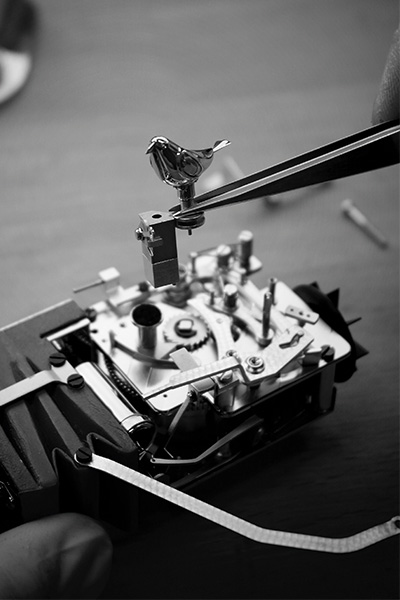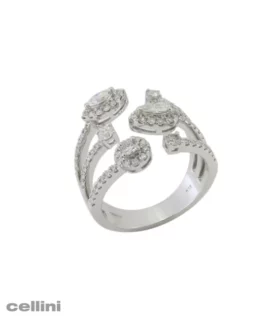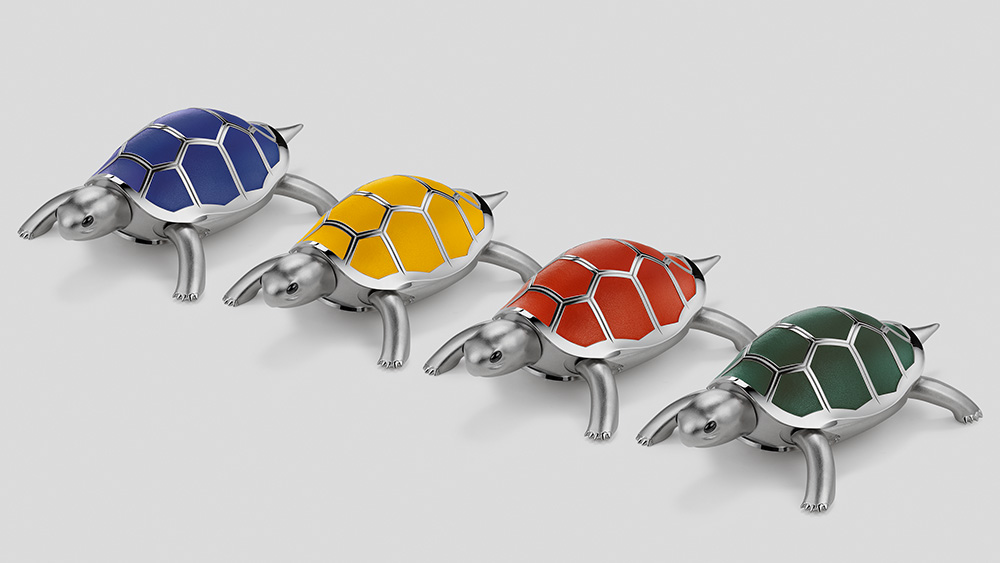
Mobile Music Machine from MB&F
Kelys & Chirp is a joyous celebration of friends. It is itself a union of Chirp and Kelys, two unlikely companions living happily together, and was developed as a co-creation by two friends: Reuge and Nicolas Court.
Kelys (from the Greek chelone or chelys for tortoise) moves in a realistic tortoise-like gait with his head moving slowly side-to-side, his movements all in synchronicity with Chirp as springing from her nest and pirouetting, her beak opening and closing, wings flapping, and tail wagging, all in time to the melodic bird song.

Chirp’s birdsong sounds amazing, both due to the accuracy of the song and for the fact that such a relatively loud sound emits from such a small object. This is thanks to a 230-year-old invention, generally credited to Pierre Jaquet-Droz (1721–1790), who came up with the idea of the modern Singing Bird complication. By 1785, Droz had both miniaturized the mechanically-controlled bird and developed a compact movement: his secret was in recreating a realistic birdsong using just one bellow of variable pitch rather than multiple single-pitch bellows. The quality of the bird’s song and how well it carries always astonishes the first time it is heard.

Court and his team added a friction clutch security system, which detects surface edges and immediately stops the turtle moving forward over the abyss… They also reintroduced a Reuge security system for the bird movement: if Chirp or her cover are accidentally pushed down while she is singing, she stops and instantly retreats to her nest.
The scales (turtles are reptiles) on Kelys’ shell are individually hand made from high quality leather in four different colors, creating a warmer and more natural feel than bare metal.
Tortoise or Turtle, What’s in a Name? While in many languages, the equivalent of the word “turtle” encompasses land-based tortoises and the same word is used for both, English on the other hand seems crystal clear. The term tortoise is used if it lives on land and turtle if it lives in the sea. But is it? Herpetologists (scientists that study amphibians) use the word turtle to describe all species of the order Testudines (turtles, tortoises, and terrapins). So yes, “Ninja Turtles” was correct. Kelys comes from the Greek chelone or chelys (turtle, tortoise).
Kelys & Chirp is available in four limited editions of 18 pieces each in blue, green, yellow or ochre.
Animation
- The tortoise walks, the bird opens from back, moves and sings
- For 10-12 seconds, the bird flaps its wings, moves its tail, opens its beak in time to the bird song, then as if magically disappears
- The tortoise moves its legs in a realistically intermittent gait, its head moves
- Average tortoise speed: 0.03 m/s (0.06 mph)
Materials
- Generally rhodium plated brass, stainless steel and 18-karat white gold for the bird
- Tortoise scales: handmade leathering with colored calfskin
Movement
- Number of components: 480
- 100% hand assembled
Chirp The Singing Bird
- 18-karat polished white gold, eyes in sapphire
- Number of components (bird alone): 30
- Number of components (bellows): 90
- Mainspring: twin-cam spring barrel
- Power reserve: three cycles of turtle walking and bird singing
- Bellows: double bellows system (bi-directional air pushing)
- Security mechanism: if the bird or cover are pushed down while the bird is singing, the bird automatically retreats
Kelys The Automaton Tortoise
- Grained, satin and polish finishing, rhodium-plated brass, eyes in black onyx gems
- Shell: 12 leather scales with individual polished edges
- Mechanism for turtle automaton is driven by the Singing Bird movement
- Number of components: 100, all rhodium or satin finished
- Gear train: elliptical gearing with max/min 1.3/0.8 ratio enables the turtle to advance with a realistically non-regular gait.
- Table/desk edge detector: turtle automatically stops when reaching the edge of the surface.
- Tail switch: world first tail indication; with the turtle’s tail up it rests in place while the bird sings; with the turtle’s tail down it walks and the bird sings.
- Security friction clutch
- Circular stainless steel winding key located on tortoise’s belly.
Dimensions and Weight
- Weight: approx. 1.4 kg
- Dimensions: 24 cm (length) × 16 cm (width) × 8 cm (height without bird open)

The Reuge spirit is to respect tradition, but at the same time move forward with beautiful contemporary music boxes for the 21st century.
It was in 1865 that Charles Reuge established his first musical pocket watch shop in Sainte-Croix, Switzerland. Charles Reuge was a pioneer, managing to incorporate a musical cylinder and a miniature comb into a watch movement. His son Albert Reuge converted the family’s atelier into a small factory in 1886 and Reuge musical movements began to feature in the most unlikely of objects, including powder compacts and cigarette lighters.
Guido Reuge, who presided over the brand for much of the 20th century, built the current Reuge manufacture in Sainte-Croix in 1930 and expanded the company. In the 1960s and ‘70s, Reuge diversified, taking over the manufacture and marketing of mechanical singing birds from Bontems and Eschle and also developed the skills and capacity to create or replicate virtually any melody. Since 2006, Kurt Kupper has been the CEO of Reuge, and under his guidance the brand has developed a particular ability to customize and create bespoke music boxes.
Nicolas Court: Nicolas Court was born in 1970 in Moutiers, Switzerland and preciously immersed in the micro-mechanical and horological aspects of the Jura mountains. After qualifying as a micro-mechanic at the technical college in Saint-Imier, Court worked on Morbier and Comtoise clocks. In 1989, he moved to Sainte-Croix and worked at T.H.A. (Techniques Horlogères Appliquées), where he discovered a passion for haute horlogerie mechanical art pieces, creating Breguet sympathique clocks and developing luxurious objects for well-known watch brands. Sainte-Croix is not only known for horology, the town is also a cradle of mechanical arts including music boxes, automatons, and gramophones. Court met automaton collectors and had the opportunity to restore historic pieces, which led to his now regular trips to China to repair and restore automatons. He also collaborates with other automaton makers in the region and develops music box modules for watch brands, working on projects under his own brand “Arts15.”
Court describes his work as “creating mechanical objects at the service of dreams.”
This devotion for mechanical arts led to several collaborations with Reuge, such as the Chiff Chaff singing bird and the Escalado Horse Race automaton; undertakings that paved the way to the design and engineering of Kelys & Chirp.

After 15 years managing prestigious watch brands, Maximilian Büsser resigned from his Managing Director position at Harry Winston in 2005 to create MB&F – Maximilian Büsser & Friends. MB&F is an artistic and micro-engineering laboratory dedicated to designing and crafting small series of radical concept watches by bringing together talented horological professionals that Büsser both respects and enjoys working with.
In 2007, MB&F unveiled its first Horological Machine, HM1. HM1’s sculptured, three-dimensional case and beautifully finished engine (movement) set the standard for the idiosyncratic Horological Machines that have followed: HM2, HM3, HM4, HM5, HM6, HM7, HM8 and HMX – all Machines that tell the time, rather than Machines to tell the time.
In 2011, MB&F launched its round-cased Legacy Machine collection. These more classical pieces – classical for MB&F, that is – pay tribute to nineteenth-century watchmaking excellence by reinterpreting complications from the great horological innovators of yesteryear to create contemporary objets d’art. LM1 and LM2 were followed by LM101, the first MB&F Machine to feature a movement developed entirely in-house. The year 2015 saw the launch of Legacy Machine Perpetual featuring a fully integrated perpetual calendar. LM SE was launched in 2017. MB&F generally alternates between launching contemporary, resolutely unconventional Horological Machines and historically inspired Legacy Machines.
As well as Horological and Legacy Machines, MB&F has created space-age MusicMachines (1, 2 and 3) in collaboration with music box specialist Reuge; and with L’Epée 1839, unusual clocks in the form of a space station (Starfleet Machine), a rocket (Destination Moon), a spider (Arachnophobia), an octopus (Octopod) and three robot clocks (Melchior, Sherman, and Balthazar). In 2016, MB&F and Caran d’Ache created a mechanical rocket-pen called Astrograph.
And there have been distinguished accolades reminding us of the innovative nature of MB&F’s journey so far. To name a few, there have been no less than four Grand Prix awards from the famous Grand Prix d’Horlogerie de Genève: in 2016, LM Perpetual won the Grand Prix for Best Calendar Watch; in 2012, Legacy Machine N°1 was awarded the Public Prize (voted for by horology fans) and the Best Men’s Watch Prize (voted for by the professional jury). In 2010, MB&F won Best Concept and Design Watch for the HM4 Thunderbolt. In 2015 MB&F received a Red Dot: Best of the Best award – the top prize at the international Red Dot Awards – for the HM6 Space Pirate.
















